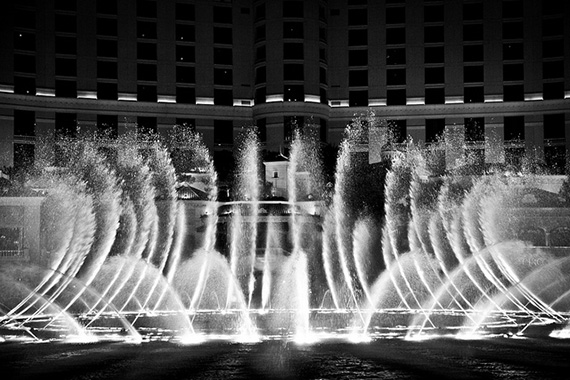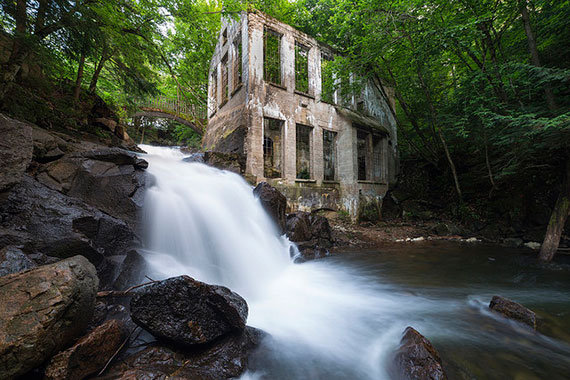If you’ve ever wanted to freeze the action on a water droplet or create a silky effect in a running stream then listen up. Shooting water is one of the most enjoyable and challenging ways to photograph really interesting natural photography. The loveliest thing about shooting water is that you can produce different effects every time you shoot. Some of these effects can be soft and flowing while other effects can be dynamic and commanding. It all is dependent on your light and your shutter.

photo by Anna Oh
In order to get a clear photograph of your water photograph you need to have the accurate level of light. Because most flowing water images are done outdoors you will have to prepare yourself for different weather. You will also need to be able to work with natural light in an effective way. Let’s take a fountain for example. Fountains in the city can supply beautifully creative shots. We can try to take photos of them two ways. We can shot the motion of the water to give the appearance like a silky-smooth ribbon. Alternatively, we can shoot the flowing water so we see every drop.
These two things depend a lot on your shutter speed. A speedy shutter means that you can stop the action. This means that you will be able to spot every droplet of water poised in the air as it shoots out to the fountain. To do so, you need a large amount of light so that you can have a fast shutter. A slow shutter speed means that you can slow the speed of motion. This produces what is called a silken effect. A silken effect is where your shutter speed slows down and the water seems like it is streaking across your shot. You also need to carefully watch your light so that you do not over expose your photograph. So how does this become applicable?

silken effect with 5 second shutter speed, photo by Dave Doe
Let me go into more detail. The longer you have your shutter open, the more light enters the sensor. It works the other way, too. The quicker your shutter speed, the less light that you have to work with. You must find the balance between what outcome you want to create and your lighting. For example, you wanted to photograph the water fountain on an dull day. Perhaps there are clouds approaching and producing some overcast light. You already have in mind that you want to stop the motion of the water so you can see each separate water drop. You know that you need a fast shutter speed to do this, but there is not much daylight in the scene. So how do you get a fast shutter speed so you can stop motion and be able to get just the right amount of light?
You would choose a very high speed of the shutter—1/8000 of a second may be your favorite. However, you see that the camera is telling you that to capture at the speed you are going to have a very underexposed and dark photo. This will not suffice at all, therefore you select a wide aperture. Remember, a wide aperture will blur your background. This might be okay given the situation. So, consequently, you choose f/4. An aperture this large will let a lot of daylight in.

photo by Kirt Edblom
You have set your shutter at 1/8000 of a second and f/4 as your aperture, but now there is another setback. The camera’s light meter is suggesting you are still not getting sufficient lighting. Is there something else you can do? Of course there is!
This is where your ISO comes in. Your ISO is the light sensitivity. When you do not have enough light you can increase your ISO. When you take pictures in auto mode, the camera will choose the ISO for you. But, when shooting in manual you have to decide it yourself. If you’re shooting fast moving water on an cloudy day, opt for a higher ISO. A high ISO is like getting another two or three f-stops of light. Even though you might not be able to get extra light through your manual setting, you can get additional light by increasing the ISO.

photo by Brad Higham
Now, what about the silken effect? You will not have to use a very high ISO if you want the silken effect on a gray day. However, if you are photographing water in a dim forest you may still have to boost your ISO.
Your ISO is a clever function that gives you more light. Keep in mind the key to images of moving water is light and shutter speed. Your shutter captures the movement of water, your aperture and ISO can take care of the light for you.
About the Author:
Amy Renfrey writes for DigitalPhotographySuccess.com. She’s photographed many things from famous musicians (drummers for Prince and Anastasia) to weddings and portraits of babies. Amy also teaches photography online to her students.
Like This Article?
Don't Miss The Next One!
Join over 100,000 photographers of all experience levels who receive our free photography tips and articles to stay current:






Thank you for using one of my photos in your article I am very flattered.
Thank you for this information, I am totally new to photographing. Enjoy reading it.
Good info…thank you.
In agreement with this, photographing water is so much fun, I am enjoying trying all different combos of shutter speed, apterture and ISO, plus dialling down (or up) the exposure compensation. I’ve also used ND filters from time to time. Half the fun is in the experimenting for me. And having the EXIF data readily available helps to know which settings work – I was going to say ‘best’ but that’s a very subjective word. Sometimes I’m after capturing the droplets of water escaping, other times I want the silken veil effect.